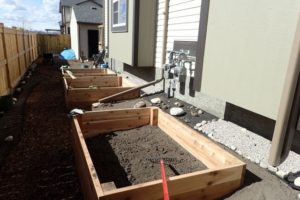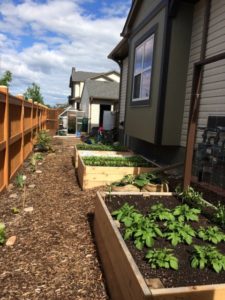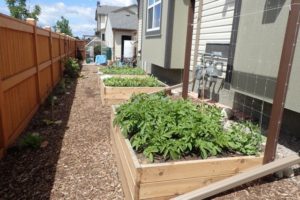-
Written by Joan Cosway-Hayes – 2017 Cochrane’s Best Yard Contest Winner
My favourite thing about my garden is being able to walk outside with a large bowl and fill it with fresh picked organic greens, herbs and veggies for salads and dinners. It’s not difficult to grow your own food. Here is what we do; I hope this inspires you.
We built 3 veggie boxes. Two are 5 X 5. One is 4 X 6. They fit our narrow side yard. We used 4 X 4 and 2 X 4 for the posts and 2 X 6 and 2 X 10 for the sides. All materials are cedar.
Top Spray Notes: MicroPro Sienna treated wood products may be used to construct raised garden beds. The MicroPro treated wood process is certified by Scientific Certification Systems, Inc. (SCS) as an Environmentally Preferable Product (EPP) based on SCS’ Life-Cycle Assessment. Very small amounts of copper and azole will migrate out of MicroPro Sienna treated wood over time. If it is desirable to minimize the migration of copper or azole into the soil of a raised garden bed, we recommend that a suitable thin plastic material be used as a barrier between the MicroPro Sienna treated wood and the raised garden bed soil. The use of a plastic barrier will also help keep soil within the bed area. For proper drainage, the plastic material should not be used underneath the raised garden bed. www.microprosienna.com
More information at this site on treated lumber: https://www.thesurvivalistblog.net/is-treated-lumber-safe-for-building-raised-bed-vegetable-gardens/
Built on a slope, the average depth of the boxes is 15 inches. We filled the boxes with NutriLoam from Top Spray. We add worm castings and home grown Bokashi fermented compost for superfood plant nutrition.
I plant seeds from high quality seed producer William Dam Seeds, using as many organic varieties as possible. I look for short growing season varieties. I plant what we love to eat. I plant rows closer than the seed directions instruct to save space; the plants always thrive. I plant the seeds carefully so that I don’t have to thin plants later on (thinning is an awful chore).
I practise companion planting; plants are much happier near their friends (ie peas like beans, carrot and lettuce but don’t like onions and garlic). I water with rain barrel water. I keep an eye out for pests and weeds. We feast all summer and fall.
If you are thinking of starting to grow veggies, here are some tips. Box size should allow you to easily reach to the centre from all sides. Don’t use existing soil or the builders “top soil” or you will spend years trying to improve the soil for plant success. Buy a good base mix like NutriLoam and add worm castings and/or finished compost throughout the growing season for extra nutrition. Buy good quality seed. Planting times depend on the year and which type of veggie. I planted most seeds May 21 in 2017 and May 4 in 2016; its a guessing game in the Cochrane area. Keep a garden journal to record planting dates, successes, best varieties, problems/remedies and harvest dates to help you next year. Experiment and learn … and most of all have fun!
305 Griffin Road West, Cochrane, AB T4C 2C4
1-888-516-8524
- Menu
- Home
- Products
- » Mulch Products
- » » Mulch Before & After Care
- » Soil Blends
- » Other Products
- Blower Truck Services
- » The Blower Truck Advantage
- » Residential
- » Commercial
- » Erosion Control
- » » EcoBlanket
- » » FilterSoxx
- » » Picture Gallery
- » TopDressing
- » Terraseeding
- » At-Grade Systems
- » Aggregate Application
- HydroSeeding
- » HydroSeeding
- » » Before and After Care
- » Titan 330 HydroSeeder
- » Picture Gallery
- Bulk Deliveries
- » Bulk Deliveries
- Edmonton Depot
- Cochrane Depot
- About Us
- » About Us
- » Contact Us
- » Our Team
- » Our Mission
- » News & Events
- » » Community Garden
- » » Cochrane's Best Yard
- » Employment
- » Testimonials




